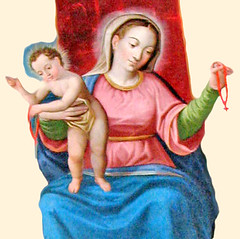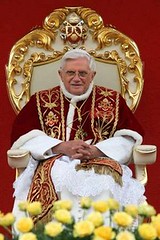Lindisfarne and her Saints
 At one time, the kingdom of Northumbria in the north of the British Isles was the cradle of Christianity in those islands. King Oswald (who was later sainted) gave the islands of Lindisfarne and Inner Farne to St Aidan and from the little island of Lindisfarne, which even today is cut off from the mainland during high tide, a monastery and diocese extended its civilizing and Christian influence throughout the land. As such, it is also commonly known as Holy Island. The Monastery (left) was sadly a victim of Viking attacks and later of Henry VIII who destroyed it during his Dissolution of the Monasteries. Lindisfarne is renown for producing the sublime Lindisfarne Gospels, and the sanctity of its Celtic bishop-saints, namely, Aidan and Cuthbert (below, in a stained glass window from Bamburgh church, site of St Aidan's death).
At one time, the kingdom of Northumbria in the north of the British Isles was the cradle of Christianity in those islands. King Oswald (who was later sainted) gave the islands of Lindisfarne and Inner Farne to St Aidan and from the little island of Lindisfarne, which even today is cut off from the mainland during high tide, a monastery and diocese extended its civilizing and Christian influence throughout the land. As such, it is also commonly known as Holy Island. The Monastery (left) was sadly a victim of Viking attacks and later of Henry VIII who destroyed it during his Dissolution of the Monasteries. Lindisfarne is renown for producing the sublime Lindisfarne Gospels, and the sanctity of its Celtic bishop-saints, namely, Aidan and Cuthbert (below, in a stained glass window from Bamburgh church, site of St Aidan's death).Even today, Lindisfarne remains a popular centre for retreats and Celtic spiritualilty. Having been there several times and also been to the church built on the reputed site of St Aidan's death (on Bamburgh), I can testify to the silence and peace of the wind-tossed island, with the swirling grey sea all around. From here, one can clearly see the power of God and His beauty.
In 2001, I gave a talk on St Aidan and his influence, which I quote in part from below:
"In 635, Aidan travelled to Northumbria with a band of monks. They were warmly welcomed by king Oswald who gave them the Island of Lindisfarne near his royal villa at Bamburgh. Here they built a monastery and a church with rough stone walls and a thatched roof, and here at Lindisfarne, Aidan established his See as bishop of the Northumbrian people. In effect, he ministered to the area covered by York, since that See was still vacant. Although he was a bishop, Aidan established a monastery on Lindisfarne under the Rule of St Columba. This monastery was called the English Iona, for from it the paganism of Northumbria was gradually dispelled and ‘barbarian customs’ undermined. Lindisfarne was a centre of learning and civilization having alumni like St Wilfrid of York and possibly Benedict Biscop (who founded Jarrow & Wearmouth). The famed Lindisfarne Gospels were produced here and a facsimile copy is housed in this College.On this day, the Church in England celebrates the memory of St Aidan, founder of the monastery of Lindisfarne and its first bishop, and all the saints of Lindisfarne. It is an occasion to give thanks to God for these saints from Ireland who brought the faith to the English from Iona, that other great Christian monastery and missionary centre. It is an opportunity to remember how God used a place like Lindisfarne as the centre for the evangelization of England and we pray that He re-enact this work in our lifetime and raise up saints like Aidan again.
Aidan was a monk and a missionary, living among the people and travelling throughout the north preaching, instructing and baptising. He divided the time of the year between missionary work, long periods with his monks at Lindisfarne and solitary periods in prayer on the island of Farne. He was tireless in caring for the welfare of the poor and of slaves, using the alms given to him by the king and his nobles to feed the needy and liberate the captive. Among these freed slaves were perhaps 12 English boys whom Aidan took to his monastery to brought up there and trained as priests. Two of these we know by name as Eata who later became bishop of Lindisfarne and Chad who became bishop of the East Saxons. Again we see in Aidan the practical side of pastoral care which goes hand in hand with the spiritual message of Christianity. Aidan founded churches in the course of his travels as well as monasteries and convents for women as well. St Hilda who was abbess of Whitby received her veil from him.
Aidan was realistic about the conversion of England and knew it would take time, and the foundations mentioned above were set up to carry on his work. But above all, his success in converting the Northumbrians must be due to his personal example of humility and patience. Oswald too contributed to this because he travelled with Aidan on his journeys so that he could translate for the Irish monk. When Oswald was killed in battle some years later against the pagan south, he was revered as a martyr. One famous story serves to highlight Aidan’s Christian example. St Bede recounts how the king had given bishop Aidan a fine horse for his journeys. One day, Aidan came across a beggar seeking alms. The saint immediately dismounted and gave his horse with all it’s royal trappings to the beggar. When the king berated Aidan and said that he could have given a less worthy horse to the beggar, Aidan said: “O King, what are you saying? Surely this son of a mare is nor dearer to you than that son of God?” The king subsequently recanted and vowed never again to “form any opinion… as to how much… to give to the sons of God.” And Aidan praised Oswald for his humility. Clearly, bishop and king had a close relationship and they worked together to spread the Gospel.
Oswald died shortly after and was succeeded by Oswin who also worked with the bishop. Finally, on the night of 31 August in 651, a boy was watching over his sheep on the hills above the river Leader in Scotland. In the darkness, he saw a vision of a great host of angels carrying the soul of a most holy man to heaven. He subsequently discovered that this great man was a bishop, Aidan who had died that night near Bamburgh where he had a mission centre. That boy’s name was Cuthbert who would later become one of the most famous of the Northumbrian saints and future bishop of Lindisfarne.
Aidan was buried in the cemetery on Lindisfarne but was later translated into the sanctuary of the church dedicated to St Peter built on that island. Today we visited Paulinus’ See at York but tomorrow we shall see the real heart of Christianity in the north. From Lindisfarne and under the direction of its first bishop, St Aidan, the Church grew. Cuthbert built on the foundations he laid, Wilfrid (whom he taught) organized the Church in Northumbria and Bede of Jarrow revived learning.
As an interesting note, I would like to point out that Bede’s only gripe with Aidan was that he celebrated Easter according to the Celtic custom (supposedly handed down by St John) whereas he adopted the Roman custom (from St Peter). It’s interesting how liturgical preferences and disagreements have always been the stuff of the Church but great saints serving God and His people can be found on all sides, so long as “good sense and moderation” is allowed to prevail."
O loving God, who called your servant Aidan from the peace of a Cloister to re-establish the Christian mission in northern England, and gave him the gifts of gentleness, simplicity, and strength: Grant that we, following his example, may use what you have given us for the relief of human need, and may persevere in commending the saving Gospel of our Redeemer Jesus Christ; who lives and reigns with you and the Holy Spirit, one God, for ever and ever. Amen.

Incidentally, Today is also the 48th anniversary of the Independence of Malaysia from British rule. May God continue to bless my motherland and her peoples, prosper her and invest her with peace, harmony and unity.








1 Comments:
Hey I think I was at the same mass as you were. It was the 10:30 AM wasn't it?
At the beginning of mass I was horrified that it seemed as though the priest was going to process down the aisle with nothing but an alb on. I guess luckily he was able to slip into a pretty nice red and green chausable right before mass.
His preaching was certainly good compared to a lot of priests I have heard here in Singapore, but still I felt as though it left something to be desired. I dont' know, maybe I'm just too picky. It was a pretty good mass though.
Post a Comment
<< Home